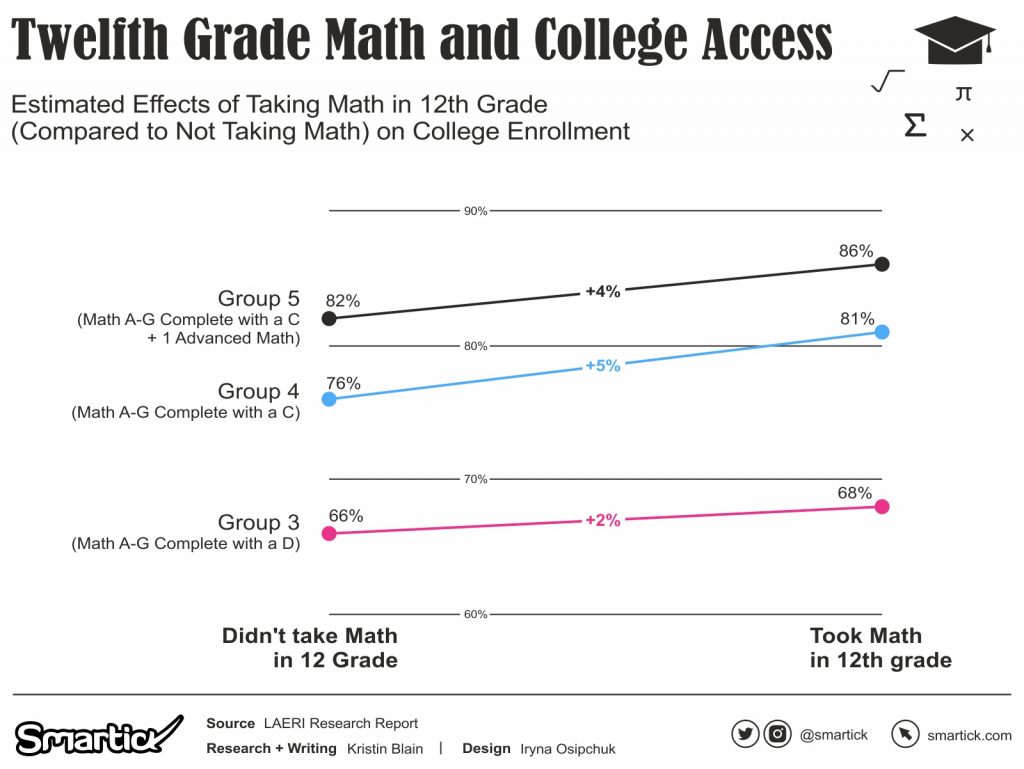
According to the Bureau of Labor Statistics, workers with a college education will on average make 84% more than those with a high school diploma. However, recent reports show that the overall college enrollment rate for U.S. high school graduates was just 40%, and that less than a third of high school graduates truly felt prepared for college.

With only 24% of the nation’s high school seniors performing at or above proficiency levels in mathematics, it should come as no surprise that many students enrolling in their freshman year of college are indeed unprepared.
The LAERI Study
A study from the Los Angeles Education Research Institute (LAERI) reported that high schools offering a robust curriculum that encourages students to continue their math education into 12th grade have positive impacts on student college enrollment and post-secondary success—with better-prepared students and far less need for those remedial college classes.
LAERI focused on a cohort of nearly 27,000 high school seniors and measured the outcomes of student grade point averages, math course completion, college enrollment, and academic persistence.
Californian public schools require that students take a series of college preparatory courses in a set of subject areas, also known as the “A-G Requirements”. To meet the Math A-G Requirement, students must complete Algebra 1, Geometry, and Algebra 2 or their equivalents with at least a C average. This coursework is often completed by the end of 11th grade, leaving those who have already met the A-G requirements the opportunity to elect additional math courses in 12th grade—if they choose.
LAERI on Improved College Enrollment Rates
Taking math in 12th grade provided a large boost to students’ completion of college preparatory coursework, such as a GPA of a C or better on the Math A-G requirements—eliminating the need for math refreshers in freshman year. It also proved to have an overall positive effect on college enrollment.
Students in LAERI the study were categorized into three groups based on their Math A-G Requirement GPAs and 12th grade coursework.
Group 5 students completed all Math A-G Requirement courses with a C or better as well as one full year of advanced math in 12th grade, such as Statistics, Precalculus, or Calculus.
Group 4 students completed all Math A-G Requirements with a C or better, taking one of these required courses for their senior year.
Like Group 4, Group 3 students completed all Math A-G Requirements taking one of these required courses for their senior year, but with an overall GPA of a D.
For Group 5, taking a full year of advanced 12th grade math improved their college enrollment rates by nearly 4%.
Students in Group 4 showed an even more substantial 5% boost in college enrollment.
Even Group 3 students, who completed all Math A-G requirements and averaged only a D in 12th grade math were 2.3% more likely to enroll in college than those who did not take math their senior year.
LAERI on Improved Postsecondary Success
Although high school seniors committed to a full year of 12th grade math experienced a slight reduction in their overall grade point average, LAERI researchers found the long-term effect of their academic tenacity to be unmistakably positive.
Researchers went on to report that students who enrolled in 12th grade math courses were more likely to be exposed to a college-focused peer group, increasing motivation for their own post-secondary enrollment.
Tackling a full year of 12th grade math also gave students a more competitive edge in college admissions processes—especially on campuses that no longer consider SAT and ACT scores but rather look for completed coursework (such as California’s A-G Requirements).
Finally, students that completed advanced math courses their senior year including Statistics, Calculus or Data Science had a higher probability of being accepted into college degree programs with direct pathways to more lucrative careers in science, technology, engineering and mathematics.
Taking on the 12th Grade Challenge
From college admissions preparations to part-time jobs and squeezing in just enough time for a social life, many 12th graders find themselves already juggling a host of responsibilities. Some even check out altogether from academics and adopt the ‘Senior Slump’.
However, 12th grade is the last step a student takes before stepping out into the real world—and the best way to go is by finding your balance, first. According to the LAERI report, making the investment in math in that final year might very well help students to walk steadily down their preferred postsecondary path.
If you or your child are getting ready for that final year and al ready feeling a little bit inundated, set up a meeting with your academic advisor to work out the best way to balance one last math course into 12th grade.

